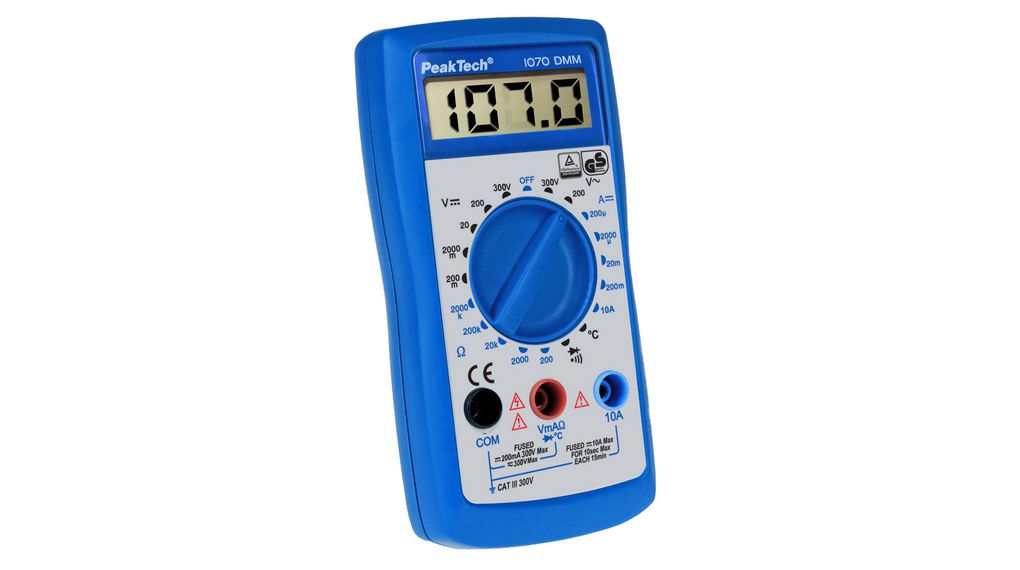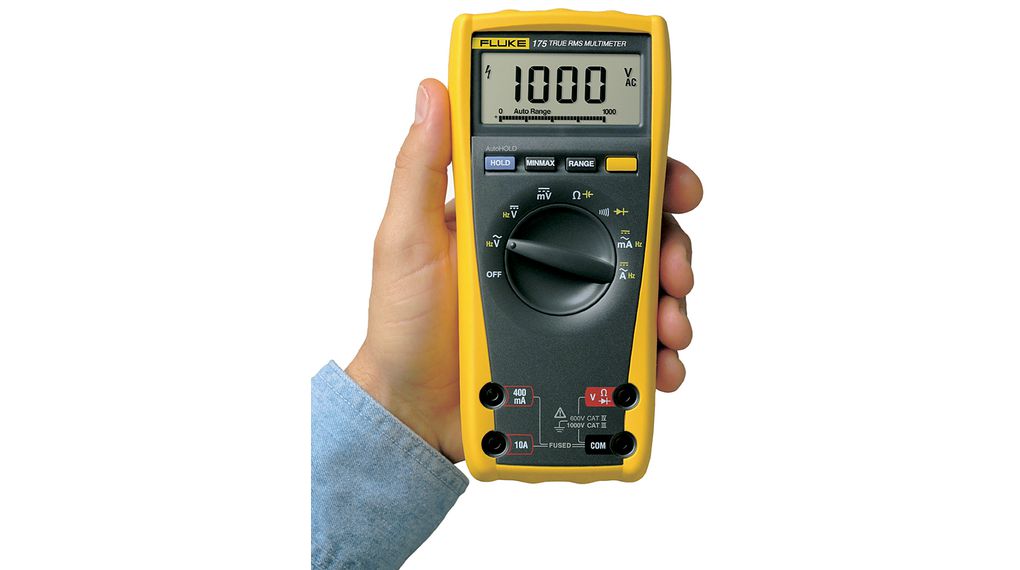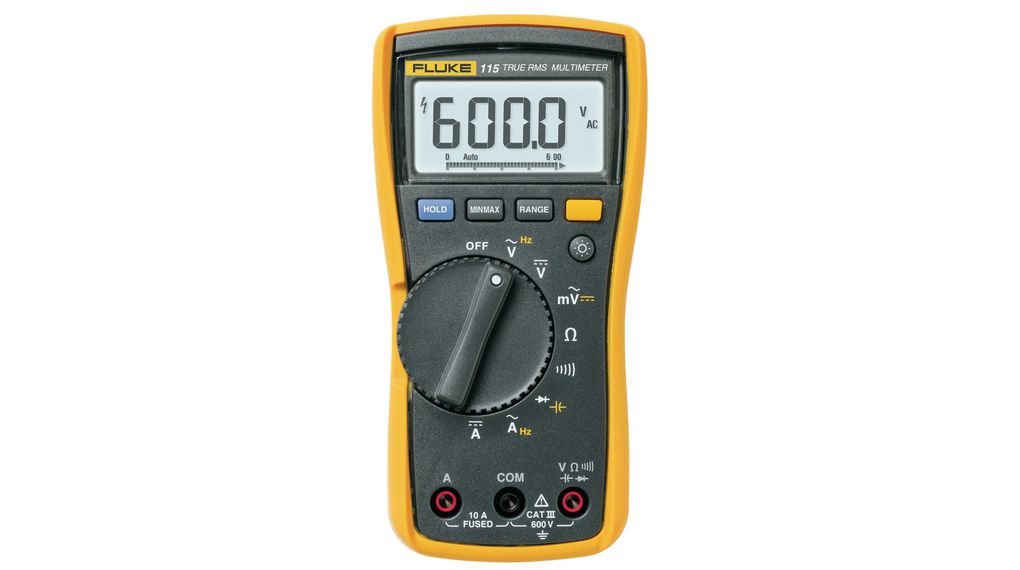Publish date: 18/09/2020
Multimeters: A complete guide

An essential piece of equipment, multimeters are a key tool used universally by technicians to measure voltage, current and resistance. Every component, from a simple diode to a complex amplifier must be tested and multimeters offer an efficient way of doing this enabling any faults within electrical circuits to be identified and isolated with ease.
Ideal for a broad range of applications, multimeters are used extensively within industries such as construction, automation and manufacturing. They are a vital piece of equipment for maintenance technicians and are indispensable for testing and repairs both within a domestic and a professional context.
What is a multimeter?
A multimeter is an electronic instrument that measures two or more values such as voltage (volts), current (amps) and resistance (ohms). Whilst the most basic of multimeters will be able to test for these measures, some more advanced models have additional capabilities.
Digital multimeters (DMMs), for instance, are often able to test for specialized measurements relating to temperature, congruity, recurrent and capacitance. Technicians with more specific requirements are therefore able to choose a multimeter that is targeted to meet their needs.
Digital multimeters have four key components:
- Display: this is where measurements are shown and can be viewed
- Buttons: these can be selected according to their function and vary between models
- Dial: this is used to select the desired measurement values (volts, amps or ohms)
- Input jacks: this is where test leads are inserted

10 considerations when choosing a multimeter
1. Intended application
The choice of multimeter will largely be determined by its intended application. Understanding exactly how the device will be used is key when considering the features and functionalities desired. For complex applications advanced multimeters with increased functionality may be most ideal whilst household applications will only require the simplest of models.

It is also worth considering the environment within which the multimeter will be used as smaller models may be more appropriate in hard-to-reach places and features such as LED backlighting will be useful in areas with poor visibility.
2. Analogue vs. Digital
Multimeters can be either analogue or digital. Analogue multimeters display measurements via the use of a needle, enabling data to be displayed quickly so that technicians can work with speed. As current can fluctuate greatly within a short amount of time, being able to obtain results immediately is useful for accurately showing sudden movements of current. Some professionals still prefer this type of multimeter as they are useful for particularly sensitive measurements and are often more durable than LED components.

However, the functionality of analogue multimeters is relatively limited. Digital multimeters have largely replaced their analogue counterparts due to their capability for measuring with greater accuracy, more reliability and increased impedance. Further, analogue models tend to be far more sensitive to shocks and vibrations making them more susceptible to damage.
Additionally, reading and logging data can be more difficult with analogue multimeters as a number of different scales and values are shown which can be confusing for users who are less experienced. Digital models display readings in a clearer, more universally understood way which can be easier to use and understand.
3. Type of multimeter
There are three main types of multimeter available; pen, handheld and bench top. Choosing which device is most appropriate will depend on the user’s requirements.
- Pen

- Handheld

- Bench top

4. Functionality
Understanding the functionality that you require from a multimeter is essential when choosing the best device. In addition to current, voltage and resistance some technicians may require measurements for other properties including diode testing, temperature and capacitance and so multimeters with this increased functionality may be needed.
It is also worth considering other features such as how robust a model is for harsh conditions, autoranging capabilities for seamless use and a data logger for those wanting to obtain readings at a later date.
The Fluke 170 Series offers a range of premium multimeters with extensive functionality for maintenance technicians. Whilst individual models will differ, this product series includes features such as:

With greater functionality comes a higher price point and so it is worth assessing how useful additional features may be. For those using the device extensively, it may be worth investing in a versatile multimeter that offers a number of specialised functions.
5. Accuracy
Accuracy refers to the greatest amount of error that can occur under specific operating conditions. It is indicated as a percentage showing how close the measurement displayed is to the actual value measured.
For example, a reading of 100.0 V on a digital multimeter with an accuracy of ±2% can range from 98.0 V to 102.0 V. Whether or not this range of accuracy is acceptable will depend entirely on the application. If a user simply wants to check whether a circuit is working properly or not then accuracy will not be a key consideration. However, for technicians requiring greater precision, a more accurate multimeter will be required.
Multimeters that offer high accuracy may need to be calibrated more frequently than those that do not. Over long periods of use or in the event of damage, the accuracy of a multimeter will deteriorate. For high accuracy applications it may be worth investing in a multimeter that can be calibrated as this will reduce the potential for deterioration and ensure that high accuracy is maintained.
6. RMS and True-RMS (TRMS)
RMS is the Root Mean Square of any AC voltage or current waveform. It is a mathematical formula used to take measurements according to the peak value of a waveform. Whilst this is useful, AC waveforms are seldom perfect due to noise caused by a number of sources including switches, computers, drives and battery chargers.
For this reason, devices that measure according to the TRMS (True Root Mean Square) which accounts for noise interruption and imperfect waveforms, provide a far more accurate and realistic calculation for measuring current. Depending on the level of accuracy required, this may be a factor to take into consideration.
7. Resolution
Display counts are the resolution of a meter shown to the smallest part of the scale. It can be used to refer to how great the number displayed on the meter is or the total number of digits displayed. The resolution of a digital multimeter is expressed by a digit and a half where a half digit can display either a 0 or 1. Handheld DMMs commonly have display digits of 3½ and 4½ digits whilst bench multimeters tend to have display digits of 5½, 6½, 7½ and 8½ digits.
The higher the display count, the more precise the data obtained will be.
| Display digits | Actual measurement range | Resolution counts |
|---|---|---|
| 3½ | +/- 1999 | 2,000 |
| 4½ | +/- 19999 | 20,000 |
| 5½ | +/- 19999 | 200,000 |
| 6½ | +/- 19999 | 2,000,000 |
8. Safety
When purchasing a digital multimeter it is essential that users consider the safety ratings for each model. Prior to using any electrical test equipment, technicians should always refer to the user’s manual for correct operating procedures, limits and precautions.
It is essential that technicians check the maximum voltage and current ratings to ensure that they are greater than the voltage ranges being tested. This can be achieved by referring to relevant safety ratings. Most multimeters will have a CAT I to CAT IV rating and some may have a third party certification such as CE.
Another safety consideration for multimeters and their accessories is the way in which they are designed as some are more safety-assured than others. Some features that ensure maximum protection include:
- an internal blast shield
- non-contact voltage tester
- shrouded banana plugs on the probes
- flanges to reduce slippage on the probes
- isolation slots to prevent arc-over
9. Compatible accessories
Multimeters are used with probes, test leads (hyperlink) and clamp meters and so ensuring that your device can be used with the compatible accessories that you require is important. Some multimeters can be purchased as part of a kit with compatible accessories included and other accessories can be bought separately to enhance your device.

10. Price
As the range of multimeters on the market is so broad, costs can vary hugely according to the model, the brand and the functionality offered. Typically, workbench multimeters are more expensive than handheld versions as they tend to be more accurate with a higher resolution. Devices that are more robust, have higher safety ratings or are calibrated are also likely to be more costly. However, given the importance of test and measurement and the key role that multimeters have as an essential device, purchasing a high quality multimeter from a reputable brand is likely an invaluable investment.
Please contact us if you require further assistance when choosing the best multimeter for your application and we will be more than happy to help.
Recommended products

Fluke 179 True-RMS Digital Multimeter and Free C25 Case and TPAK Fastening Set
The Fluke 179 is a precise and reliable multimeter offering a digital display with analog bar graph and built-in temperature measurements. This bundle includes a free C25 case and TPAK Fastening Set.
Shop now
Fluke 115 Digital Multimeter 600V, 50kHz, 40MOhm
The Fluke 115 Multimeter with True RMS has a maximum voltage of 600V, 10A current measurement and is CAT III safety rated. This SureGrip Master Accessory Set includes 13 items including test leads and test probes.
Shop now
Metraline DM62 Gossen MetraWatt Digital Multimeter
This auto-ranging TRMS multimeter offers reliable measurements with additional safety features thanks to automatic blocking sockets (ABS). The compact and ergonomic design is safe and easy-to-use.
Shop now
UNI-T UT58E Digital Multimeter
This multimeter has a large screen to help users obtain readings quickly and clearly. This device offers 20000 display count, 0.05% accuracy and a data hold function so that measurements can be retained after use.
Shop now